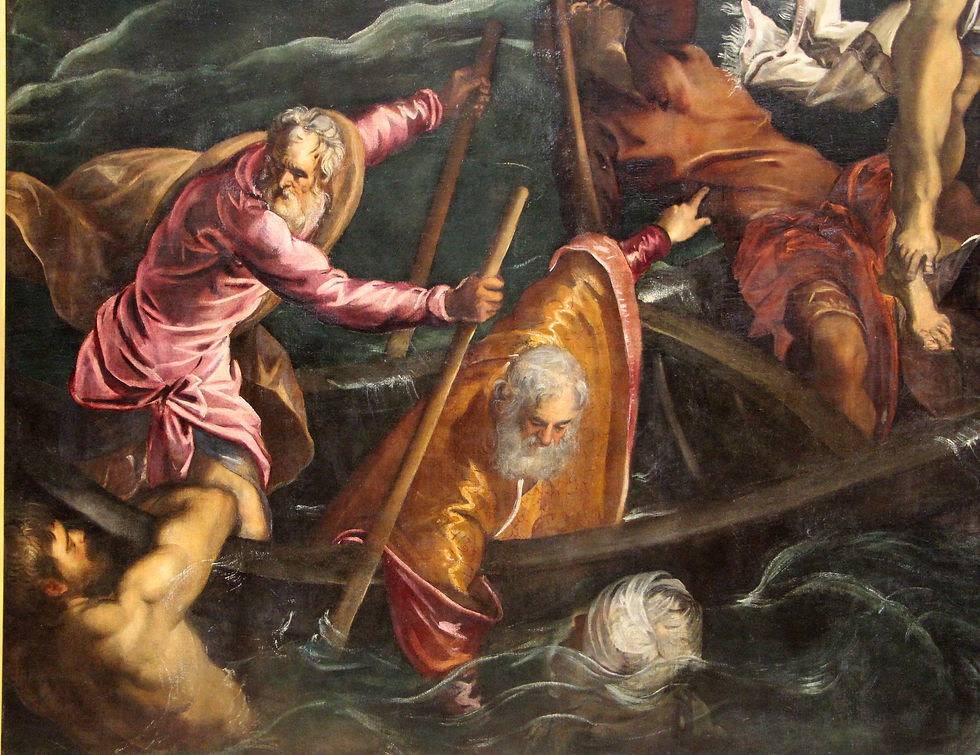April 25 St. Mark the Evangelist's Feastday
- Profiles in Catholicism

- Dec 18, 2018
- 3 min read

St. Mark the Evangelist was St. Peter's protégé. He apparently had several aliases which has sometimes confused Bible readers. Many bible historians also identify him as three people mentioned in the Acts of the Apostles, - John Mark (which the Greek Orthodox church still calls him), John, and Mark. Some scholars speculate that he was the young man who ran away naked when Christ was arrested in Gethsemane which could make him the first streaker in history. Some other early scholars claim that Mark was originally a Jewish priest and subsequently cut off his thumb to make himself unfit for the priesthood after he decided to follow Christ and there are references in third century writings to his stumpy fingers.
Mark traveled extensively with both St. Peter and St. Paul but didn't get along too well with Paul and a breach between the two soon developed. When Paul refused to take Mark on his second missionary trip, Mark went to Cyprus with his cousin St. Barnabas to teach the Gospel. Mark's authorship on The Gospel According to St. Mark was basically from the viewpoint of St. Peter for whom he acted as an interpreter when Peter went to Rome. In fact, Peter refers to Mark as "his son" (Peter 5:13).
St. Peter appointed Mark as Bishop of Alexandria and Mark spent his last twelve years preaching in Northern Africa. When Mark finally returned to Alexandria, he was accused of witchcraft, bound. and dragged through the streets for several hours on a rope tied to an ox. The following day he was put through the same torture and died and was buried in Alexandria.
Mark's relics were allegedly stolen by two sailors in 828 and taken to Venice The local religious and civic authorities quickly elected St. Mark as Venice's patron saint, and the apostle's traditional symbol--a winged lion--became the logo of the Venetian Republic. The Byzantine Basilica of St. Mark was built t to house the relics. There is a mosaic on this Venetian basilica showing how the sailors covered the body relics with a layer of pork. Since Muslims are not allowed to touch pork, Mark's porkification was done to prevent Muslim intervention in the relics removal.
St. Mark's feastday is a major holiday in Venice and in other parts of Italy, especially Sicily where the day is celebrated with biscotti di San Marco, delicate cookies flavored with Marsala wine, honey, and anise .There are several great films that take place in Venice on or near the Piazza San Marco that may enhance your enjoyment of these biscotti. such as A Death in Venice (1871), Don't Look Now (1974), Summertime (1956), and The Comfort of Strangers (1991). But as a counterpoint to the sacred history of St. Mark in Venice, I recommend Dangerous Beauty (1998) based on the book The Honest Courtesan, by Margaret Rosenth which has subsequently been adapted into a stage musical. The film is about a young girl who is forced into prostitution and becomes the highest paid courtesan in 16th century Venice, to be subsequently accused of witchcraft by the Inquisition. Catherine McCormack's performance as the courtesan is as delicious as these biscotti.
Biscotti di San Marco (St. Mark's Cookies)
Ingredients
3 cups sifted flour 3 teaspoons baking powder 1/2 cup granulated sugar 1/2 cup chopped almonds 1/2 cup shortening
3 eggs (reserve 1 egg white) 1/3 cup honey 3 TB Marsala wine 1 TB anise seed
Instructions
Sift flour, measure, and resift with baking powder, sugar, and anise seed. Add nuts. Cut shortening in with fingers until well blended. Warm honey slightly.Make a well in flour, put eggs, Marsala, and warm honey into it and knead into a smooth ball. Dough should be firm and manageable; if it is too soft and sticky, add more flour.Preheat over to 350º FRoll dough into oblong loaf 5 inches wide and 1/2-inch thick. Place on a greased cookie sheet, brush top with reserved egg white, and bake until golden brown, about 30 minutes. Cool slightly. Cut into 1-inch slices. Store in airtight container. They will keep fresh for weeks.
© 2011 Gordon Nary



